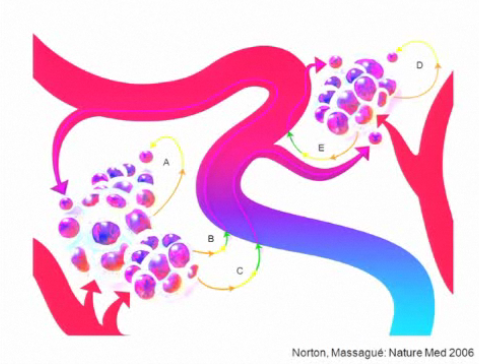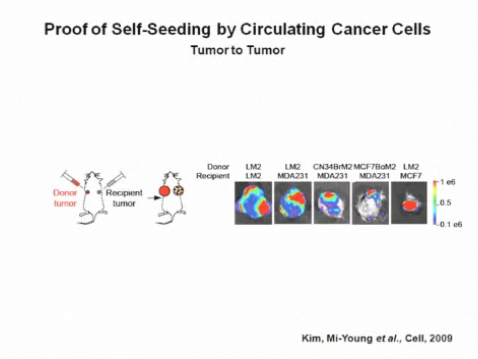Cancer Cell Seeding – a new hypothesis from Larry Norton
At the annual NY Chemotherapy Foundation symposium the other week, one of the highlights for me was listening to Larry Norton (MSKCC) give a 30 minute keynote entitled:
“Cancer Cell Seeding: a hypothesis with therapeutic implications”
He talked at length about what he described as some of the breast cancer mysteries, namely the puzzles associated with:
- Phenotypic consistency (hyperplasia, anaplasia, rapid growth, angiogenesis, large tumour size, invasion, metastases and latency)
- Disorderly order
- Unclear clear margins
Several main points were then raised from this quick synopsis:
- The phenotypic elements are so inextricably linked that they must be related, but how?
- Sentinel node mapping proves that progression is orderly. Yet it isn’t! How?
- RT must kill cells that are beyond clear margins. How do they get there? What is their relationship to distant recurrence?
- That RNA expression is prognostic and predictive challenges the notion of tumour-initiating cells being rare.
These issues or assumptions may be true or not true so the question then becomes how are we going to solve them?
Norton noted that one way these concepts may be related is that the tumour is essentially metastasing to itself and showed a nice schematic from 2006 that he and Massague used in their Nature Medicine paper. Tumours thus grow by metastasis back to itself and will promote increased growth and bigger tumour size:

However, it took until late 2009 to research and publish proof that this idea is true (see reference below for the paper):

The other concept that caught my attention is the idea of a ‘toxic sponge’ that followed on from this as Norton was putting the story back together in terms of breast cancer. In short, the primary tumour and region act as a sponge for circulating tumour cells. When the sponge is removed or sterilised, circulating tumour cells seek distant sites since they cannot metastasise back to the primary tumour anymore. Seeding the new sanctuary sites may also create reservoirs for feeding future distant metastases. Research is now underway to determine whether RT has accelerates or potentiates the metastasis process in the long run.
All in all, a very interesting and well put together talk.
![]() Norton L, & Massagué J (2006). Is cancer a disease of self-seeding? Nature medicine, 12 (8), 875-8 PMID: 16892025
Norton L, & Massagué J (2006). Is cancer a disease of self-seeding? Nature medicine, 12 (8), 875-8 PMID: 16892025
Kim, M., Oskarsson, T., Acharyya, S., Nguyen, D., Zhang, X., Norton, L., & Massagué, J. (2009). Tumor Self-Seeding by Circulating Cancer Cells Cell, 139 (7), 1315-1326 DOI: 10.1016/j.cell.2009.11.025
3 Responses to “Cancer Cell Seeding – a new hypothesis from Larry Norton”
[…] to see how the idea pans out. I can’t help wondering how this research will impact the Norton and Massagué cancer seeding theory – it should add to it. Now, if only we can find out what activates the CPE-ΔN protein, […]
[…] those of you looking for some background on this important topic, check out this previous post on cancer cell seeding […]
[…] metastasis, ie cancers from spreading to other organs of the body. Many of you will remember the post on Norton and Massague’s cancer cell seeding theory and this new finding could well have […]
Comments are closed.